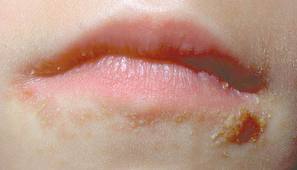[su_divider top=”no” style=”double” divider_color=”#952524″ link_color=”#952524″ size=”2″ margin=”10″]
What is impetigo? How to manage it? What are the precautions to be taken? What are the signs and symptoms? What is the cause of this disease? How to treat it? How can homeopathy help you? All of this answered, in this post and of course our doctors always there to help you. Just fill in your details in the form down below and we will answer all your questions for FREE!
[su_divider top=”no” style=”double” divider_color=”#952524″ link_color=”#952524″ size=”2″ margin=”10″]
[sc name=”query”]

What is impetigo?
Impetigo is a highly contagious bacterial skin infection. Impetigo is caused by staphylococcus and streptococcus bacteria. Impetigo commonly occurs in children and is also called school sores.
It is a superficial infection of the skin.
A break in the skin allows the bacteria to enter and cause infection.
In children, impetigo develops at the nasal openings. Inflammation occurs at the nasal openings with cold and watery discharge from the nose.
Adults may develop impetigo if they are in close contact with infected children.
Basics: The bacteria from the environment colonize on the skin surface but they do not produce disease unless the skin is disrupted.
Commomly Impetigo occurs in?
Impetigo affects people of all ages but children between 2-5 years are more at risk. It occurs in both men and women but men are at higher risk.
Causes of impetigo?
Major causative bacteria for the formation of impetigo are staphylococcus and streptococcus. The bacteria enter through a lesion or a cut in the skin and their it grows to cause infection and inflammation.
Impetigo can also occur on the skin without the visible lesion. It may occur in the upper respiratory tract.
Non-bullous impetigo is caused by both staphylococcus and streptococcus bacteria.
Bullous impetigo is caused by staphylococcus bacteria.
Types of impetigo?
There are two types of impetigo are there:
-Non-bullous impetigo:
It appears as small red papules that evolve to small blisters than to pustules and finally scabs with characteristic honey-colored crusts.
-Bullous impetigo:
This type of impetigo causes the formation of blisters called bullae on the skin that contains clear yellow fluid. These bullae are fragile and on bursting leave a raw red skin and ragged edges. A dark crust develops that resolves while healing.
Impetigo signs and symptoms?
The lesions represent it as:
-Pustules that grow progressively.
-Round and oozing patches.
-Spread to other areas on scratching.
-Blisters or golden yellow crusts form.
-There may be lymph adenopathy.
-Lesions occur on exposed areas of the body.
Does impetigo stay in your body forever?
Impetigo is no longer infectious after the treatment or once the sores or blisters dried and healed.
Is impetigo dangerous?
Impetigo is not dangerous. Sores are in a milder form of infection which generally heal without scarring.
Investigations for impetigo?
-Diagnosis is mainly based on the appearance of the lesion.Other skin conditions which mimic the lesions of impetigo are scabies and ringworm.
-Bullous impetigo needs to be differentiated from skin conditions that produce bullae such as herpes cold sores, chickenpox, poison ivy, skin allergies, eczema, and insect bites.
-Culture of the lesion is done to confirm the presence of bacteria.
In order to decide whether topical antibacterial creams or oral antibiotics should be used, medical evaluation or culture tests are necessary.
Treatment for impetigo?
-Antibacterial cream in mild cases.
-Oral antibiotics in severe cases.
-Cover the affected area.
-Avoid close contact with others.
-Use separate towels.
-Change and wash the clothes and linen daily.
Management for impetigo?
-Anti-oxidant rich fruit helps building up immunity and fight infection.
-Soups are a rich source of energy.
-Juices of fresh vegetables like carrot, beets, etc.
-Avoid fried food, dairy products, refined sugar, and fatty red meat.
What are the complications of impetigo?
-Kidney failure.
-Scarring may occur.
-An infection may spread to other parts of the body.
Homeopathic treatment for impetigo?
-Antimonium tartaricum
-Arsenic
-Dulcamara
-Kali bichromate
-Lyco
-Mezerium
-Rhus tox
-Viola
-Antimonium crudum
-Cicuta
-Graphites
-Sulphur
For more information, you can visit WebMD and eMedicine.
impetigo
[su_divider divider_color=”#952524″ link_color=”#952524″ size=”2″ margin=”10″]
[sc name=”know-your-doctor”]
[sc name=”more-links-diseases”]

